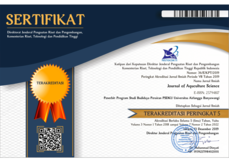Effects of Dietary Coffee Husk Fermentation on The Growth of Catfish (Pangasianodon hyphophthalmus)

Coffee husk fermentation (CHF) might be utilized as an alternative plant protein source. This research evaluated dietary CHF supplementation's effects on growth for striped catfish. This study consisted of five grade levels of CHF as a treatment. The treatments were P0 (without the addition of CHF), P1 (addition of 6% CHF), P2 (addition of 12% CHF), P3 (addition of 18% CHF), and P4 (addition of 24% CHF). The results determined that dietary CHF inclusion had no significantly different effect on specific growth rate (SGR) and feed efficiency (P > 0.05). However, the P1 group (6% CHF) produced the best protein retention (PR), which was significantly different from the control (P0) and other CHF treatments (P < 0.05). No significant differences were observed in survival rates among the treatments. The inclusion of CHF up to 24% in the diet was found acceptable, as it did not negatively impact the striped catfish’s overall health or growth performance. Although growth rate, feed efficiency, and survival did not significantly differ (P > 0.05).
Copyright (c) 2025 Azmi Afriansyah, Mohamad Amin, Ade Dwi Sasanti, Sefti Heza Dwinanti, Tanbiyaskur Tanbiyaskur

This work is licensed under a Creative Commons Attribution-NonCommercial-ShareAlike 4.0 International License.



















